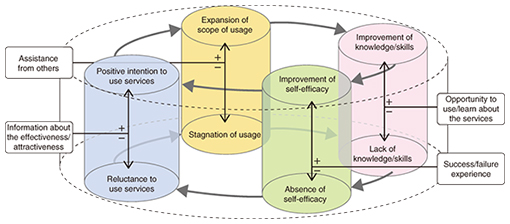 |
|
|
|
|
|
Feature Articles: Service Design for Attractive Services and Trends in Design Thinking Vol. 13, No. 12, pp. 48–51, Dec. 2015. https://doi.org/10.53829/ntr201512fa9 Methodology for Creating Attractive ServicesAbstractNTT IT Corporation provides consulting services to help companies create services that will appeal to their customers. In this article, we introduce some of the methodologies employed by the ICT Design department to design services that capture people’s interest. We also discuss points that need to be considered with respect to user interviews and our interpretations of them as well as the generation and evaluation of ideas. Keywords: service design, human-centered design, user experience 1. IntroductionAn important issue for many companies is the creation of services that appeal to users. Human-centered design and user experience (UX) design represent ways of thinking that are known to be effective in this regard. Under these approaches, a service’s users are carefully studied, ideas are brainstormed based on the users’ needs, prototypes are rapidly developed, and then the prototypes are repeatedly evaluated and improved. There are many systematized service development methodologies such as this one. However, to actually implement a service that will impress and appeal to people, it is not sufficient to simply apply a methodology as-is. Methods must be appropriately selected and customized—and their designs polished—according to each user’s circumstances, reactions, and goals at any particular moment. The employees in NTT’s laboratories have accumulated many years of practical expertise along with experience researching and developing these types of methodologies. The ICT Design department of NTT IT Corporation (NTT-IT) specializes in providing consulting services that apply these methodologies and expertise. This is all connected to the creation of information and communication technology (ICT) services that appeal to people by using the appropriate methodology for any given context. In this article, we introduce several methodologies that have been put into practice by NTT-IT. 2. Understanding the target userWe conduct ethnographic investigations to gain a deeper understanding of the target users. In these investigations, we visit the users, collect data, and analyze on-site user behavior (eg., at home, at work); we also conduct interviews to reveal aspects of the unconscious mind. Although these investigations are said to be an easy way to understand users, we need to interpret and analyze minute details in our data to avoid being deceived by superficial remarks. For example, we use the Modified Grounded Theory Approach (M-GTA), in which everything the subject says is labeled and structured in detail. We used this same approach in the past to create a mental model (called NARUTO) of the users of ICT services, as shown in Fig. 1. The base of this model shows a negative psychological feedback loop in which limited use of the ICT services causes learning to stagnate; this prevents users from feeling confident, which in turn reduces their interest in the services and therefore limits their use of the service.
There are four elements that break the negative cycle and hold the key to encouraging positive feedback loops toward the top of the model: assistance from others, opportunity to use/learn about the services, successful experiences, and information about the effectiveness/attractiveness. If we can find the essential causes influencing people’s actions and thoughts in this way, we can also apply this knowledge when developing services. When we actually designed support services based on this model and provided them to Internet-averse senior citizens, we observed some examples of surprisingly positive change. It takes a long time to build a model like this from scratch. As a result, there are also many cases in which we proceed to brainstorm ideas and search for solutions without spending much time on conducting investigations and analysis; for example, we may make use of existing models and user data that we have already collected. By emphasizing the process of evaluating designs we have created in cases like these, we can understand the users’ needs through the entire service development process and thus refine our services. 3. Coming up with ideasAppealing services are not uniquely guided by users’ needs. We occasionally need innovative ideas in order to take mental leaps forward. The ICT design game and cross-boundary methodology are effective techniques for coming up with ideas that start with the users’ needs. 3.1 ICT design gameThe ICT design game is an application of Scandinavian spatial design methods to ICT services. The game is a type of forced association technique that pushes ideas for services in a particular direction, forcing business areas and technology to be associated with the needs of a service’s users (as identified through user investigations). For example, consider the price sensitivity of people who would like to exercise more but cannot justify the expense of joining a gym because they do not believe they would continue exercising for very long. By associating this need with medical insurance (a business area), we can come up with ideas such as a service that reduces the price of insurance as people get healthier through exercise. The ICT design game assumes that several people will brainstorm ideas together and is also characterized by the inclusion of techniques for bringing out each participant’s creativity. Specifically, the game introduces a variety of rules; for example, each person speaks in order, building upon the idea proposed by the previous speaker. The rules are intended to leverage the diversity present among several participants. Left to think alone, individuals often follow familiar trains of thought and thus have a tendency to get stuck on solutions that represent local optimums. By providing mechanisms that allow people to apply and share their own cognitive strengths, we combine a variety of perspectives to increase the probability of coming up with good solutions. Even people who are not used to contributing ideas can participate in this method and we have found that this method can produce a wider variety of concrete ideas than unstructured brainstorming. 3.2 Cross-boundary methodologyNTT-IT has developed the cross-boundary methodology to push the boundaries of diversity even further. Specifically, by choosing people with a variety of backgrounds and values to come up with ideas, we are creating diversity amongst the group’s members themselves. For example, if we wanted to create a new service to help people enjoy traveling and commuting, we would hold a session in which a variety of people could exchange ideas—from train fanatics to night club workers who regularly use taxis to celebrities who must exercise caution when moving about in public. We have often noticed that project members who develop a service have strong feelings about the project. Although these feelings can drive the project forward, they sometimes result in strong assumptions that make it difficult to get past preconceived notions. We can think outside the box and increase the probability of coming up with innovative ideas by inviting people whose cultures and value systems significantly differ from those of the project members. 4. Evaluating service ideasOnce a service’s design has solidified to some extent, we enter the next phase of our methodology: quickly visualizing our ideas so that we can evaluate and improve upon them. To get users to ultimately accept our service, we need to determine which part of the service appeals to them and verify that they are not encountering any obstacles that prevent them from using it; it is important to then steadily improve the service as necessary. Therefore, NTT-IT is particularly focused on the evaluation step. Although evaluation methods that collect feedback directly from the actual (target) users through interviews appear quite simple at first glance, it is actually rather difficult to correctly intuit users’ opinions and make improvements based on them. This is because even if we present the same service to the same user on different occasions, that person’s reactions will vary based on how questions are asked, how the person is feeling, and many other possible factors. For example, during a past interview to evaluate the design of an event recommendation service—specifically, whether people would like to use it—we received the following response from a (male) interviewee. “Sounds good to me. I’ve become more and more reluctant to look for [events], so—for example—if I have a chance, I could look at my choices and say ‘I guess I’ll try hiking today.’” However, when we conducted the same interview with the same person five months later, we received the following negative response. “This app is hard to use, the things I have to tap are really small, my eyes get tired […] and it’s just a bit of a pain, you know?” As this anecdote shows, it is dangerous to evaluate a service at the planning stage by simply taking what users say at face value; figuring out how to interpret these responses is important. Specifically, we focus our attention on listening to what users are evaluating negatively—and why—to find hints for areas of improvement. In the first of the two sample responses given above, the user was focusing on the concept behind the service itself; in the second sample response, on the other hand, the user was focusing on actual interactions with the service. In other words, if reactions to the concept behind the service itself are positive, it is possible that people will actually use the service. However, given that assumption, we need to simplify and remove any friction that may exist in user interactions. To accurately collect user feedback in the ICT Design department, we developed a three-step receptivity evaluation method and are finding ways to improve the process of asking questions itself. Under this method, we ask questions to identify people’s needs and to clarify how they will use the service before we ask for any opinions on the concept behind the service. We cannot understand why we have received a negative reaction to a service’s concept until we have first determined whether anyone needed that service in the first place and whether that service was suited to the context in which it would be used. Through this process of improving how we ask questions and collecting accurate evaluation results, we can get many useful hints for improving services. 5. Future workIn this article, we introduced some of our methodologies for creating attractive services. There are various other techniques and expertise applicable to designing services that appeal to users; by ascertaining users’ circumstances and reactions along with market conditions and company strategies, we can perfect our designs through repeated trial and error. The ICT Design department comprises a multidisciplinary team of experienced UX designers and engineers as well as researchers knowledgeable of human characteristics. The department is supported by the combination of each person’s domain knowledge with a variety of techniques for applying that knowledge. We plan to continue to develop and deploy services that both appeal to and are enjoyed by as many people as possible. |






